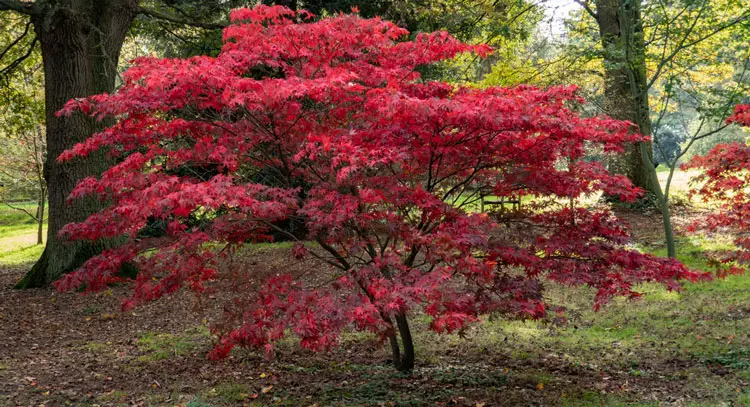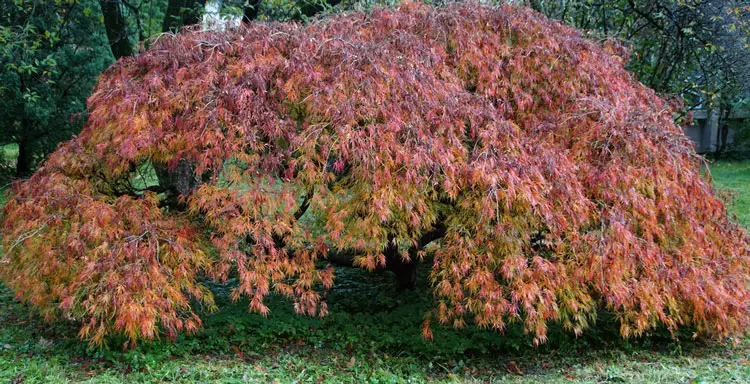Can You Grow a Maple Tree Indoors?

This post follows our research editorial guidelines.

Fewer trees are more synonymous with the cool crisp yellows, oranges, and vibrant reds that adorn northern landscapes in autumn than the maple tree. With unmistakable leaf shapes and colors, maple trees provide aesthetic appeal to any space they’re in. It’s no wonder then that many plant owners want to replicate the beauty of the maple tree inside their homes. Maple trees add depth and warmth and freshen the indoor air by reducing dust, bacteria, mold, and carbon dioxide.
While it’s tempting to add the vibrance of a maple tree to your indoor space, the question so many curious plant owners are asking is whether maples will thrive indoors. The short answer (and with the proper care and attention) is yes! So which varieties of maple trees do best indoors?

Table of Contents
Many dwarf Japanese maple trees do well both indoors and outdoors. Since many Japanese maple varieties are best suited for zones 5-8, cooler regions may have trouble establishing ornamental trees outdoors. Because of this, I recommend some of the following Japanese maple varieties.
Which Maple Trees Do Well in Pots?
Red Dragon Japanese Maple
these compact, low-growing trees with stunning purplish-red leaves in autumn. Red dragon maple trees reach 10 ft tall at maturity and are often used in bonsai because of their natural outward growing habit. Because of their size and growth habits, the red dragon Japanese maple trees make ideal potted trees. For the most success when growing indoors, find a bright east-facing room and avoid placing the tree in a hot corner that gets afternoon sun. Your new tree will thank you for it.

Velvet Viking Japanese Maple
While most maple trees do best in bright, east-facing conditions where they can enjoy the warmth of the morning sun and the shade in the afternoon heat, the Velvet Viking Japanese maple is one of the hardiest of the Japanese maple trees and does well in south or west facing exposure better than others. The Velvet Viking does best in zones 4-9 and will tolerate cooler conditions if you choose to keep your potted tree in a three-season sunroom or on a patio. But, if you’re looking to brighten up a dull corner in your home with a vibrant plant, the Velvet Viking is a great choice. The Velvet Viking has showy reddish/purple foliage throughout the growing season that deepens in the fall. At 3 ft tall, the Velvet Viking makes for a beautiful addition to any home.
Ribbon-Leaf Japanese Maple
As the name would suggest, this ornamental Japanese maple tree is an excellent addition to a bright, well-lit home. The Ribbon-leaf Japanese maple is typically found in rock gardens and is regularly planted for its tall, upright, and broad growth. The foliage emerges bright red in the spring, turning to green and gold in the summer, and dark burgundy in the summer. This easy-to-care-for tree makes it an easy choice for any home. Because of its slow-growing nature, you’ll enjoy it in your space for many years.
But with so many varieties to choose from, you can hardly go wrong. “Japanese maple trees have a variety of shapes, and their range of leaf colours, shapes and autumn colours makes for year-round interest.” writes the Royal Horticulturalist Society (RHS) of Britain. “Japanese maples will grow well in a range of soils, so this doesn’t need to be a big limiting factor on what you choose.”

5 Steps to Grow a Japanese Maple:
1. Proper water/soil mixture.
When planting your maple tree, I recommend using slightly acidic soil and letting the soil dry between waterings. Japanese maple trees won’t tolerate being waterlogged, so be careful not to water too much. Using a pot with drainage holes, or even a terracotta pot will help keep the moisture off the roots while avoiding detrimental root rot.
2. Light Requirements
While maple trees require plenty of bright light, morning or south sun is best to ensure the leaves won’t burn in the hot afternoon light. During the dormancy period, Japanese maple trees should be placed in a cool space with indirect natural light. A garage with a bright window or outdoor greenhouse is best, however, a shed with a large window will also work.
3. Pruning Needs
Regardless of their location, Japanese maple trees require regular pruning to achieve and maintain their shape. While pruning may be done mainly to achieve an ornamental look, it’s also necessary for preventing the tree from outgrowing your indoor space.
4. Annual maintenance
like all deciduous trees, maple trees require a dormancy period during the winter months. To achieve this, maple trees must be provided with the right light conditions during the growing season and throughout the winter months. Creating an environment that mimics their natural needs will reward you with a tree that thrives and shows off year-round.
5. Repotting requirements
Younger maple trees require repotting each year or when the root ball begins to reach both sides of the bottom of the container. Simply get a larger pot with good drainage, add soil mixture, gently place the original (smaller) pot on its side to remove the tree, place it into the new pot and cover it with soil. Be sure to water frequently to help it establish itself in its new home. Note that repotting should be done before or after the growing season, usually in April or September.
How Long Do Maple Cuttings Take to Root?
So what if you want to try propagating a new maple tree from a cutting. Maybe you have someone in your life with a thriving maple tree in their home that you’d like to add to your collection, or you simply want to create another plant from an older tree in your yard.
How to Establish a new plant from a cutting
Establishing a new plant from a cutting is possible with a bit of practice and good luck, follow these steps to make sure your new plant establishes well:
- Use the right tools – a clean and sharp shear or penknife will work fine and ensure that the adult tree doesn’t damage in the process.
- Fill a small pot with good drainage with equal parts peat moss, good quality soil, and coarse sand. Mixing together the ingredients will provide the right amount of nutrients and drainage needed for the cutting(s) to establish a root system.
- Cut a shoot from a healthy, well-established tree in summer before the tree begins its dormancy cycle.
- Plant the cutting(s) in the prepared soil mixture and cover the base well enough so that the bottom of the plant isn’t exposed.
- Water the soil around the base regularly until the soil is moist to the touch. Place a plastic bag around the stem cutting to help reduce the loss of moisture.
- Place the cutting in a bright spot, away from direct sunlight. Indirect light will help it grow without burning the delicate branch.
- Remove the plastic bag once a day and mist the cutting. After misting the cutting enough to wet the soil, replace the plastic bag. Repeat this step for the first two weeks while the initial roots begin to form.
- You can now move the cutting(s) to an indoor place in your home that receives direct sunlight for part of the day. Remember, the east or south sun is best for maple trees. Remove the plastic bag and continue to mist the soil each day. Gently tug on the cutting to feel if any roots have formed. If you feel resistance, you know you’ve been successful!
- Now that you have created a new plant, you can move your pot to a more desired, permanent location. Keep watering the plant regularly to assist its growth and maturity.
What Do You Do With a Potted Japanese Maple in the Winter?
As deciduous trees, maple trees still need to go through a dormancy period during the winter months. Since your home’s climate remains relatively the same year-round, you’ll need to mimic the outdoor change in conditions to keep the tree happy. But how do you do that? I recommend moving your pot out to a bright, unheated garage or insulated shed. If you don’t have a window in your garage or shed, you can also move the tree outdoors for the winter months. Make sure that you wrap the plant in a burlap sack, however, to protect the tree from wind and heavy snow, if your region’s prone to that. Once the weather is warm enough in spring, bring your tree back into your living space and provide it with some much-needed nutrients. Then, watch it come back to life.
It’s tempting to want to bring a piece of fall into your home to brighten up an otherwise lacklustre corner, and with the right variety and careful care and attention, it’s easy to accomplish this with maple trees. While each variety has its unique qualities, so many of the Japanese dwarf varieties are ideal for potting and bringing indoors. Whether you let it grow untouched (aside from regular care, attention, and annual pruning), or prune it into a bonsai shape, your Japanese maple tree will reward you with interesting foliage, lovely bark,, and bright transitional leaves throughout the growing season. And, when it gets too tall, it will make a lovely addition to any yard, without having to move it from the pot.
